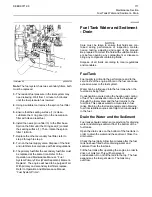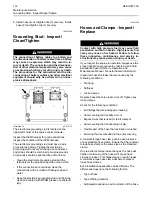
Do not operate the engine with the Instruction
Plate cover removed from the clutch. Personal in-
jury may result.
If the clutch is damaged to the point of burst fail-
ure, expelled pieces can cause personal injury to
anyone in the immediate area. Proper safeguards
must be followed to help prevent accidents.
i08254039
Radiator
-
Clean
Note:
Adjust
the
frequency
of
cleaning
according
to
the
effects
of
the
operating
environment.
Inspect
the
radiator
for
these
items:
damaged
fins,
corrosion,
dirt,
grease,
insects,
leaves,
oil,
and
other
debris.
Clean
the
radiator,
if
necessary.
Personal injury can result from air pressure.
Personal injury can result without following prop-
er procedure. When using pressure air, wear a
protective face shield and protective clothing.
The maximum air pressure for cleaning purposes
must be reduced to 205 kPa (30 psi) when the air
nozzle is deadheaded.
Pressurized air is the preferred method for removing
loose debris. Direct the air in the opposite direction of
the air flow. Hold the nozzle approximately 6 mm
(0.25 inch) away from the fins. Slowly move the air
nozzle in a direction that is parallel with the tubes.
This movement will remove debris that is between
the tubes.
Pressurized water may also be used for cleaning.
The maximum water pressure for cleaning purposes
must be less than 275 kPa (40 psi). Use pressurized
water to soften mud. Clean the core from both sides.
Use a degreaser and steam for removal of oil and
grease. Clean both sides of the core. Wash the core
with detergent and hot water. Thoroughly rinse the
core with clean water.
After cleaning, start the engine and bring the engine
to high idle. This procedure will help in the removal of
debris and drying of the core. Stop the engine. Use a
light bulb behind the core to inspect the core for
cleanliness. Repeat the cleaning, if necessary.
Inspect the fins for damage. Bent fins may be opened
with a “comb”. Inspect these items for good condition:
welds, mounting brackets, air lines, connections,
clamps, and seals. Make repairs, if necessary.
i02568202
Starting
Motor
-
Inspect
Perkins
recommends
a
scheduled
inspection
of
the
starting
motor.
If
the
starting
motor
fails,
the
engine
may
not
start
in
an
emergency
situation.
Check
the
starting
motor
for
proper
operation.
Check
the
electrical
connections
and
clean
the
electrical
connections.
Refer
to
the
Service
Manual
for
more
information
on
the
checking
procedure
and
for
specifications
or
consult
your
Perkins
distributors
for
assistance.
i06101140
Walk-Around
Inspection
Inspect
the
Engine
for
Leaks
and
for
Loose
Connections
A
walk-around
inspection
should
only
take
a
few
minutes.
When
the
time
is
taken
to
perform
these
checks,
costly
repairs
and
accidents
can
be
avoided.
For
maximum
engine
service
life,
make
a
thorough
inspection
of
the
engine
compartment
before
starting
the
engine.
Look
for
items
such
as
oil
leaks
or
coolant
leaks,
loose
bolts,
worn
belts,
loose
connections,
and
trash
buildup.
Make
repairs,
as
needed:
• The guards must be in the proper place. Repair
damaged guards or replace missing guards.
• Wipe all caps and plugs before the engine is
serviced in order to reduce the chance of system
contamination.
NOTICE
For any type of leak (coolant, lube, or fuel) clean up
the fluid. If leaking is observed, find the source and
correct the leak. If leaking is suspected, check the flu-
id levels more often than recommended until the leak
is found or fixed, or until the suspicion of a leak is
proved to be unwarranted.
NOTICE
Accumulated grease and/or oil on an engine or deck
is a fire hazard. Remove this debris with steam clean-
ing or high pressure water.
116
SEBU9071-06













































